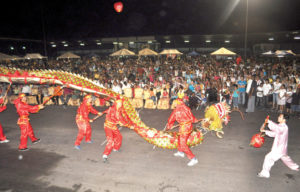Also known as the Spring Festival, the Chinese New Year in pre-modern times signalled to farmers in China to begin preparation for the sowing of their fields.

At the Chinese New Year, people traditionally wear red clothes and give children “lucky money” concealed in red envelopes. Red symbolizes fire, which, according to legend, can drive away bad luck. The fireworks that shower the festivities are rooted in a similar ancient custom. Long ago, people in China lit bamboo stalks, believing the crackling flames would frighten evil spirits.
In Guyana, many families with Chinese heritage also celebrate the occasion and would also join the Diplomatic Community in their festivities.
The Lantern Festival marks the end of the New Year season and afterwards life goes on as per normal.
Another tradition is the lighting of firecrackers. These are an important element and are traditionally let off to frighten away ghosts so the New Year could start free of them. Legend has it that long ago there was a monster that terrorised people. However, it was afraid of loud noises, bright lights and the colour red. At midnight on the last day of the old year, these things are used to frighten away the monster for the whole year.
A special treat around this time are the dumpling-shaped like Yuanbao, gold coins representing prosperity.
Pre-Chinese New Year Preparations (February 8–14, 2018)
Laba Festival
Some Chinese start to celebrate and prepare for New Year as early as month 12 day 8 of the lunar calendar. This is a festival called Laba Làbā /laa-baa/ ’12th lunar month’ + ‘8’). It’s January 24 in 2018.
Cleaning the House
Persons also clean their houses before Chinese New Year
From the 23rd of the 12th lunar month (February 8, 2018), Chinese people carry out a thorough cleaning of their houses. The cleaning is called “sweeping the dust”, and represents a wish to put away old things, bid farewell to the old year, and welcome the New Year.
New Year Shopping
People buy New Year food and snacks, New Year decorations, and clothes for New Year before New Year’s Eve. Chinese New Year, like Christmas in China, is a shopping boom time.
Chinese people may be thrifty most of the time, but they seem quite generous in their spending during their traditional festivals. For example, they buy everyone new clothes for the festival, whether they need them or not. There are New Year street markets on the days before the festival.
New Year’s Eve Activities (February 15, 2018)
Putting Up New Year Decorations
Although some people decorate their houses several days before the festival, most people do it on New Year’s Eve. Houses are decorated with red lanterns, red couplets, New Year paintings, and red lanterns. 2018 is a year of the Dog, so dog images will appear on decorations.
Chinese New Year decorations are more complex in rural areas where people not only wish good luck for their family, but also for their livestock. Hence, people not only decorated their houses, but also the places where their livestock live.
Enjoying a Reunion Dinner
Chinese New Year Eve dinner
The New Year’s Eve Feast is a “must do” dinner with all family members reuniting. Chinese try very hard to make this family event, often traveling long distances. This is the main reason for the huge travel stress throughout China.
People from north and south China eat different foods on this special occasion, and many New Year foods are symbolic. In northern China a traditional dish for the feast is jiaozi (dumplings).
They are shaped like old Chinese ingots, symbolizing wealth. Southern Chinese eat niangao (sticky rice cake) on this special day, because niangao sounds like “yearly higher”, symbolizing improvement.
The Chinese New Year has been celebrated for 3,000 years. Festivities include the lion and dragon dances and parades with traditional costumes.
Setting Off Firecrackers and Fireworks
The moment New Year arrives there is a cacaphony of fireworks and firecrackers all around, even in rural China. Families stay up for this joyful moment.
The tradition is to set off one string of small firecrackers first, followed by three big firecrackers, which symbolize “sounding out” the old year and “sounding in” the new year. The louder the three firecrackers, the better and luckier it’s believed it will be for business and farming in the coming year. (Guyana Times Sunday Magazine)



